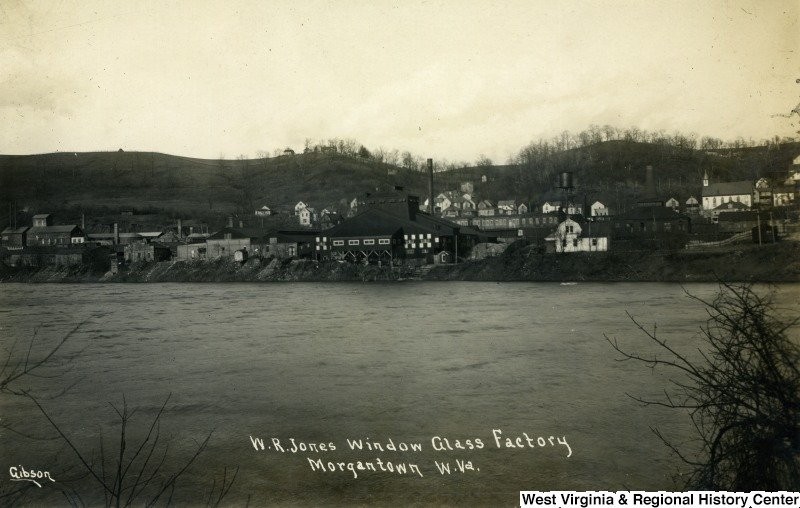W. R. Jones Glass Factory (1902-1940s)
Introduction
Text-to-speech Audio
Images
Located on the Monongahela River and near the B&O Railroad, the W. R. Jones Glass factory utilized Sunnyside's transportation methods to bring in raw materials and ship out finished products.West Virginia and Regional History Center, WVU Libraries

The W. R. Jones Glass Company was a major manufacturer of window glass, a branch of the glass industry that mechanized early on. Postcard courtesy of the West Virginia and Regional History Center, WVU Libraries.

Backstory and Context
Text-to-speech Audio
In 1901, Walter A. Jones commissioned the building of the W.R. Jones Glass Company on the Monongahela River, directly behind the successful Seneca Glass Company. His company holdings were previously located in Indiana, but West Virginia had better access to natural gas.1 His original purchase was a small plot from the Morgantown Glass Co. right along the Monongahela River.2 In 1902, Jones purchased three additional lots from George S. Sturgis, president of the Morgantown Investment Co., and land from the Morgantown Brick Company.3 The W.R. Jones Glass Company factory was ready for operation later that year.4 The buildings, all ironclad, included the main factory, the flattening house, two warehouses, and a hay barn.5 The new factory was praised for being one of the most modern in the country, for it used the latest equipment in the window glass industry. The factory included a 48-blower tank, which kept a lake of molten glass ‘fired’ from the beginning to end of the season. The factory hired up to 200 workers who ran the factory around the clock. Their convenient location on the B&O Railroad enabled this large scope of business and its success.6 In 1904, the original factory was destroyed in a fire and then rebuilt.7
Mechanization of the plant began in 1910 and was complete by 1921, with the glass manufactured solely by a mechanized process. The mechanization of the glassmaking process greatly increased productivity for the plant, though it changed the nature of work for the company glassworkers. The glassworkers at the W.R. Jones Glass Company were skilled craftsmen who were transferred to an assembly line system of work when the company mechanized.
In 1913, the W.R. Jones Glass Company, Marilla Glass Company, and Jones Machinery Company were incorporated into the United States Window Glass Company. Window glass, also known as flat or plate glass, was one of three branches of the larger regional glass industry, which included glass tableware and container glass. Each branch of the glass industry had distinct operations, factories, technologies, and glassworkers of unique skillsets.8
In 1927, the company was forced to auction their holdings in front of the Monongalia Courthouse. All the United States Window Glass Company’s holdings including both the lots for the Marilla Glass plant on Decker’s Creek, the former W. R. Jones lots, all buildings, factories, plants, warehouses, boilers, machines, and tools, were sold to French O. Garwood.9 Blocks 31 and 41, the former home of W. R. Jones Glass Company would transfer hands at least three more times in the next fifteen years. Most of the buildings would stand through the 1940s. The dismantling of the Window Glass Company reflected a broader decline of Morgantown industry in the mid-twentieth century.
Today, no buildings stand from the original W.R. Jones factory. Greer Steel Company bought the land in 1960 to build a dock. Today, the land is still owned by the Greer Steel Company and is empty except for an access road to the dock.10
Sources
1. Justin M. Kunkle, “W. R. Jones Glass Company," Prosperity and Education Edition of The New Dominion, Morgantown, W. Va. (Morgantown, W. Va.: New Dominion Pub. Co, 1903).
2. Deed of Sale, Morgantown Glass Works to W.R. Jones Glass Co., Dec 14, 1901, Morgantown, Monongalia Co., West Virginia, Book 62, p. 206. Monongalia County Clerk’s Office, Morgantown, WV.
3. Deed of Sale, George C. Sturgis to W.R. Jones Glass Co., Jan 3, 1902, Monongalia County, West Virginia, book 62, p. 300, Monongalia County Clerk’s Office, Monongalia County, WV.; Deed of Sale, Morgantown Brick Co. to W.R. Jones Glass Co., Feb 3, 1902, Book 62, p. 439, Office of the Recorder of Deeds, Morgantown, WV.
4. Sanborn Map Company, Morgantown, Monongalia County, West Virginia: June 1899, Scale: 50ft=1inch, Fire Insurance Maps for West Virginia, West Virginia and Regional History Center.
5. Kunkle, “W. R. Jones Glass Company."
6. Ibid., 35.
7. Earl L. Core, The Monongalia Story: A Bicentennial History, Vol. IV (Parsons, WV: McClain Pringing Company, 1982), 415-516.
8. Ken Fones-Wolf, “Glass Industry,” The West Virginia Encyclopedia, e-WV. Accessed January 2018, https://www.wvencyclopedia.org/articles/2116
9. Deed of Sale, United States Window Glass Company to French O. Garwood, March 31, 1927, Monongalia County, West Virginia, Book 215, p. 117, Office of the Recorder of Deeds, Morgantown, WV.
10. Deed of Sale, Frances S. Jarvis to Greer Steel Company, Feb 8, 1960, Monongalia County, West Virginia, Book 582, p. 35, Office of the Recorder of Deeds, Morgantown, WV.
Images:
“W. R. Jones Window Glass Factory, Morgantown, W. Va.” Photo. West Virginia and Regional History Center, WVU Libraries. Accessed January 2018. http://wvhistoryonview.org/catalog/wvulibraries:8091
"Bird's Eye View of Morgantown, W. Va." Postcard. 1908. West Virginia and Regional History Center, WVU Libraries. Accessed January 2018.http://wvhistoryonview.org/catalog/wvulibraries:31887
Research compiled by Katelyn Bosch. Edited by Elizabeth Satterfield and Pamela Curtin.
